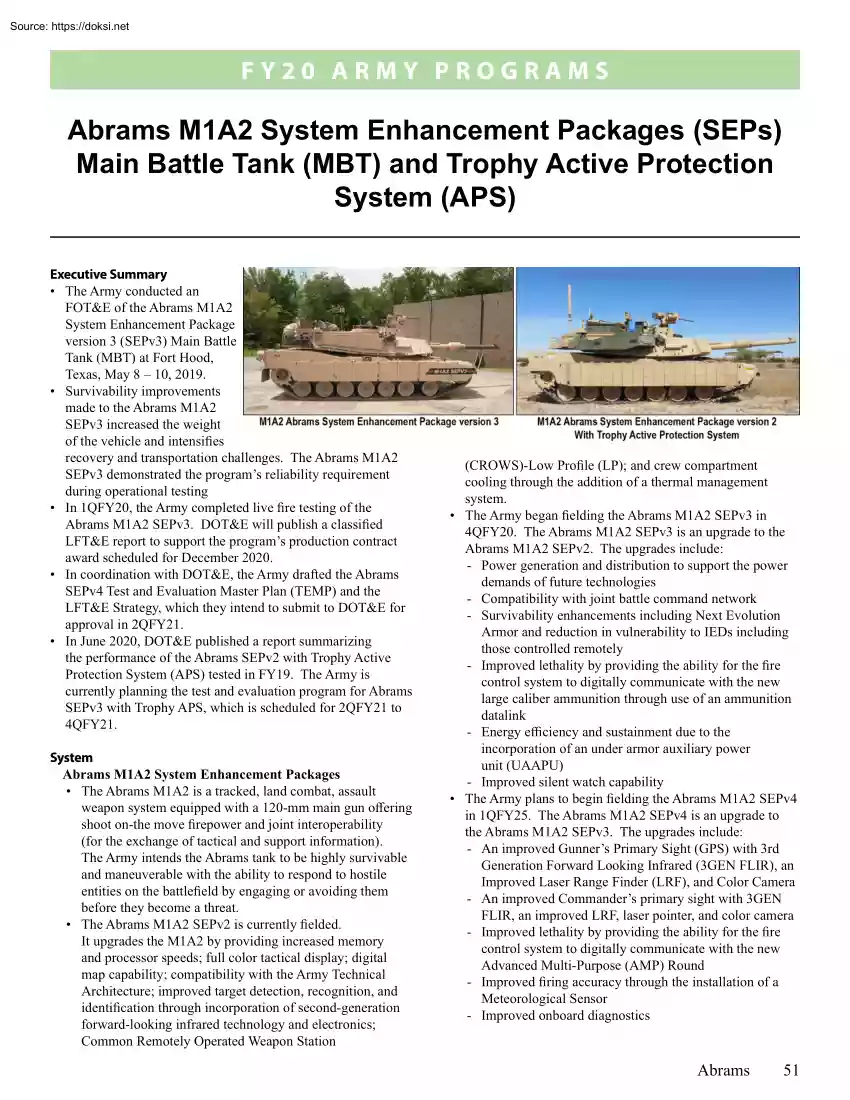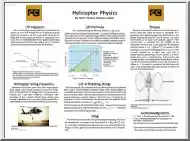Please log in to read this in our online viewer!

Please log in to read this in our online viewer!
No comments yet. You can be the first!
What did others read after this?
Content extract
FY20 ARMY PROGRAMS Abrams M1A2 System Enhancement Packages (SEPs) Main Battle Tank (MBT) and Trophy Active Protection System (APS) Executive Summary • The Army conducted an FOT&E of the Abrams M1A2 System Enhancement Package version 3 (SEPv3) Main Battle Tank (MBT) at Fort Hood, Texas, May 8 – 10, 2019. • Survivability improvements made to the Abrams M1A2 SEPv3 increased the weight of the vehicle and intensifies recovery and transportation challenges. The Abrams M1A2 SEPv3 demonstrated the program’s reliability requirement during operational testing • In 1QFY20, the Army completed live fire testing of the Abrams M1A2 SEPv3. DOT&E will publish a classified LFT&E report to support the program’s production contract award scheduled for December 2020. • In coordination with DOT&E, the Army drafted the Abrams SEPv4 Test and Evaluation Master Plan (TEMP) and the LFT&E Strategy, which they intend to submit to DOT&E for approval in 2QFY21. • In June
2020, DOT&E published a report summarizing the performance of the Abrams SEPv2 with Trophy Active Protection System (APS) tested in FY19. The Army is currently planning the test and evaluation program for Abrams SEPv3 with Trophy APS, which is scheduled for 2QFY21 to 4QFY21. System Abrams M1A2 System Enhancement Packages • The Abrams M1A2 is a tracked, land combat, assault weapon system equipped with a 120-mm main gun offering shoot on-the move firepower and joint interoperability (for the exchange of tactical and support information). The Army intends the Abrams tank to be highly survivable and maneuverable with the ability to respond to hostile entities on the battlefield by engaging or avoiding them before they become a threat. • The Abrams M1A2 SEPv2 is currently fielded. It upgrades the M1A2 by providing increased memory and processor speeds; full color tactical display; digital map capability; compatibility with the Army Technical Architecture; improved target
detection, recognition, and identification through incorporation of second‑generation forward‑looking infrared technology and electronics; Common Remotely Operated Weapon Station (CROWS)‑Low Profile (LP); and crew compartment cooling through the addition of a thermal management system. • The Army began fielding the Abrams M1A2 SEPv3 in 4QFY20. The Abrams M1A2 SEPv3 is an upgrade to the Abrams M1A2 SEPv2. The upgrades include: -- Power generation and distribution to support the power demands of future technologies -- Compatibility with joint battle command network -- Survivability enhancements including Next Evolution Armor and reduction in vulnerability to IEDs including those controlled remotely -- Improved lethality by providing the ability for the fire control system to digitally communicate with the new large caliber ammunition through use of an ammunition datalink -- Energy efficiency and sustainment due to the incorporation of an under armor auxiliary power unit
(UAAPU) -- Improved silent watch capability • The Army plans to begin fielding the Abrams M1A2 SEPv4 in 1QFY25. The Abrams M1A2 SEPv4 is an upgrade to the Abrams M1A2 SEPv3. The upgrades include: -- An improved Gunner’s Primary Sight (GPS) with 3rd Generation Forward Looking Infrared (3GEN FLIR), an Improved Laser Range Finder (LRF), and Color Camera -- An improved Commander’s primary sight with 3GEN FLIR, an improved LRF, laser pointer, and color camera -- Improved lethality by providing the ability for the fire control system to digitally communicate with the new Advanced Multi-Purpose (AMP) Round -- Improved firing accuracy through the installation of a Meteorological Sensor -- Improved onboard diagnostics Abrams 51 FY20 ARMY PROGRAMS Trophy Active Protection System • The Army intends to install the Trophy APS on the Abrams M1A2 SEPv2 and SEPv3 tanks and field four Armor Brigade sets to Army prepositioned stocks domestically and outside of the continental
United States (OCONUS). • The Army intends the Trophy APS to improve the survivability of ground combat vehicles against anti-tank guided missiles (ATGMs), rocket-propelled grenades (RPGs), and recoilless rifle threats. • The APS includes search radars to detect, identify, and track incoming threats, and a set of kinetic projectiles intended to intercept the incoming threat. • The Abrams base armor is expected to absorb threat by‑products generated after a successful intercept. The Trophy APS adds approximately 5,000 pounds to the Abrams tanks. Mission • Commanders employ units equipped with the Abrams M1A2 SEP tanks to maneuver across the full range of military operations and destroy the enemy by fire. MBT’s equipped with APS offer additional defense against ATGMs, RPGs, and recoilless rifle threats. • The Army intends the Abrams M1A2 SEP tank to defeat and/ or suppress enemy tanks, reconnaissance vehicles, infantry fighting vehicles, armored personnel
carriers, anti-tank guns, guided missile launchers (ground- and vehicle-mounted), bunkers, dismounted infantry, and helicopters. Activity • All testing was conducted in accordance with the DOT&E‑approved TEMP and test plans. Abrams M1A2 System Enhancement Packages • The Army conducted an FOT&E of the Abrams M1A2 SEPv3 at Fort Hood, Texas, May 8 – 10, 2019. The test unit consisted of Armored elements from the 1st Brigade, 1st Cavalry Division. Test events included long and short duration mounted surveillance missions. The Army conducted a cybersecurity adversarial assessment. • The Army continued developmental testing in FY20 following conclusion of the May 2019 operational test. • The Army began fielding the Abrams M1A2 SEPv3 domestically and OCONUS in FY20. • In 1QFY20, the Army completed live fire testing of the Abrams M1A2 SEPv3 tank. The last test series in the program evaluated the ability of kinetic threats to perforate the internal ammunition
compartment and the subsequent reaction of the stowed ammunition on the Abrams M1A2 SEPv3 tank mission and the crew. • DOT&E will publish a classified Abrams M1A2 SEPv3 LFT&E report in 1QFY21 to support the program’s production contract award, scheduled for December 2020. • In FY20, in coordination with DOT&E, the Army drafted the Abrams SEPv4 TEMP and LFT&E Strategy, which they intend to submit to DOT&E for approval in 2QFY21. Trophy Active Protection System • In 4QFY19, the Army completed the testing of the Abrams SEPv2 with Trophy APS, which included maneuver, gunnery, and live fire test events. In June 2020, DOT&E published a classified test report summarizing the Abrams SEPv2 with Trophy APS performance. • The Army is currently planning the live fire test program for Abrams SEPv3 with Trophy APS. The test program is scheduled for 2QFY21 through 4QFY21. Assessment Abrams M1A2 System Enhancement Packages • The Armored test unit equipped
with the Abrams M1A2 SEPv3 accomplished its assigned task in 19 of 20 missions during operational testing. The UAAPU improves the unit’s ability to accomplish continuous operations, and the upgrades have not degraded the vehicle’s combat capability. Fuel usage when operating the Abrams M1A2 SEPv3 with the UAAPU was 78 percent less than the amount used when running the main engine at idle for the same amount of time. • Upgrades mitigate the Army’s identified capability gaps for the Abrams M1A2 SEPv2. • The Abrams M1A2 SEPv3 demonstrated 441 mean miles between combat mission failures (MMBCMF), exceeding its requirement of 320 MMBCMF during operational testing. • The Abrams M1A2 SEPv3 upgrades introduce suitability concerns. Weight growth limits the tank’s tactical transportability. The M1A2 SEPv3 is not transportable by current recovery vehicles, tactical bridges, or heavy equipment transporters. Crews had difficulty operating government-furnished equipment. The
CROWS-LP thermal sight washed out during operations and had difficulty receiving software reloads. The Army could not reproduce the thermal wash out during testing. • The UAAPU reduces the acoustic detectability range of the Abrams M1A2 SEPv3 by 62 percent, when compared to the Abrams M1A2 SEPv2. • DOT&E continues to analyze the live fire test data to evaluate the Abrams M1A2 SEPv3 survivability and force protection against operationally expected threats. DOT&E will publish the M1A2 SEPv3 survivability and force protection evaluation details in a classified report in 1QFY21. 52 Abrams Major Contractors • General Dynamics Land Systems – Sterling Heights, Michigan • DRS/Rafael – St. Louis, Missouri FY20 ARMY PROGRAMS Trophy Active Protection System • The Abrams SEPv2 with Trophy APS classified report published in June 2020 summarizes the system performance and the test and evaluation recommendations for Abrams SEPv2 with Trophy APS testing. The
Army is maturing the existing vulnerability modeling and simulation tools to complement future system assessments. • The initial live fire test plan for Abrams SEPv3 with Trophy APS does not include relevant threats identified by the Intelligence Community. • Trophy APS was acquired as an Urgent Materiel Release effort without officially documenting operational requirements, which affected the test planning process. Recommendations The Army should: 1. Evaluate the survivability of the Abrams SEPv3 with Trophy APS against the most stressing threats identified by the Intelligence Community . 2. Develop operationally relevant requirements for the Abrams M1A2 tank with and without the Trophy APS. 3. Continue to develop and advance the appropriate modeling and simulation tools needed to support the test planning and evaluation of systems equipped with APS. 4. Consider the findings of the DOT&E and Army LFT&E SEPv3 evaluation reports to enhance the survivability of future
Abrams tank upgrades Abrams 53 FY20 ARMY PROGRAMS 54
2020, DOT&E published a report summarizing the performance of the Abrams SEPv2 with Trophy Active Protection System (APS) tested in FY19. The Army is currently planning the test and evaluation program for Abrams SEPv3 with Trophy APS, which is scheduled for 2QFY21 to 4QFY21. System Abrams M1A2 System Enhancement Packages • The Abrams M1A2 is a tracked, land combat, assault weapon system equipped with a 120-mm main gun offering shoot on-the move firepower and joint interoperability (for the exchange of tactical and support information). The Army intends the Abrams tank to be highly survivable and maneuverable with the ability to respond to hostile entities on the battlefield by engaging or avoiding them before they become a threat. • The Abrams M1A2 SEPv2 is currently fielded. It upgrades the M1A2 by providing increased memory and processor speeds; full color tactical display; digital map capability; compatibility with the Army Technical Architecture; improved target
detection, recognition, and identification through incorporation of second‑generation forward‑looking infrared technology and electronics; Common Remotely Operated Weapon Station (CROWS)‑Low Profile (LP); and crew compartment cooling through the addition of a thermal management system. • The Army began fielding the Abrams M1A2 SEPv3 in 4QFY20. The Abrams M1A2 SEPv3 is an upgrade to the Abrams M1A2 SEPv2. The upgrades include: -- Power generation and distribution to support the power demands of future technologies -- Compatibility with joint battle command network -- Survivability enhancements including Next Evolution Armor and reduction in vulnerability to IEDs including those controlled remotely -- Improved lethality by providing the ability for the fire control system to digitally communicate with the new large caliber ammunition through use of an ammunition datalink -- Energy efficiency and sustainment due to the incorporation of an under armor auxiliary power unit
(UAAPU) -- Improved silent watch capability • The Army plans to begin fielding the Abrams M1A2 SEPv4 in 1QFY25. The Abrams M1A2 SEPv4 is an upgrade to the Abrams M1A2 SEPv3. The upgrades include: -- An improved Gunner’s Primary Sight (GPS) with 3rd Generation Forward Looking Infrared (3GEN FLIR), an Improved Laser Range Finder (LRF), and Color Camera -- An improved Commander’s primary sight with 3GEN FLIR, an improved LRF, laser pointer, and color camera -- Improved lethality by providing the ability for the fire control system to digitally communicate with the new Advanced Multi-Purpose (AMP) Round -- Improved firing accuracy through the installation of a Meteorological Sensor -- Improved onboard diagnostics Abrams 51 FY20 ARMY PROGRAMS Trophy Active Protection System • The Army intends to install the Trophy APS on the Abrams M1A2 SEPv2 and SEPv3 tanks and field four Armor Brigade sets to Army prepositioned stocks domestically and outside of the continental
United States (OCONUS). • The Army intends the Trophy APS to improve the survivability of ground combat vehicles against anti-tank guided missiles (ATGMs), rocket-propelled grenades (RPGs), and recoilless rifle threats. • The APS includes search radars to detect, identify, and track incoming threats, and a set of kinetic projectiles intended to intercept the incoming threat. • The Abrams base armor is expected to absorb threat by‑products generated after a successful intercept. The Trophy APS adds approximately 5,000 pounds to the Abrams tanks. Mission • Commanders employ units equipped with the Abrams M1A2 SEP tanks to maneuver across the full range of military operations and destroy the enemy by fire. MBT’s equipped with APS offer additional defense against ATGMs, RPGs, and recoilless rifle threats. • The Army intends the Abrams M1A2 SEP tank to defeat and/ or suppress enemy tanks, reconnaissance vehicles, infantry fighting vehicles, armored personnel
carriers, anti-tank guns, guided missile launchers (ground- and vehicle-mounted), bunkers, dismounted infantry, and helicopters. Activity • All testing was conducted in accordance with the DOT&E‑approved TEMP and test plans. Abrams M1A2 System Enhancement Packages • The Army conducted an FOT&E of the Abrams M1A2 SEPv3 at Fort Hood, Texas, May 8 – 10, 2019. The test unit consisted of Armored elements from the 1st Brigade, 1st Cavalry Division. Test events included long and short duration mounted surveillance missions. The Army conducted a cybersecurity adversarial assessment. • The Army continued developmental testing in FY20 following conclusion of the May 2019 operational test. • The Army began fielding the Abrams M1A2 SEPv3 domestically and OCONUS in FY20. • In 1QFY20, the Army completed live fire testing of the Abrams M1A2 SEPv3 tank. The last test series in the program evaluated the ability of kinetic threats to perforate the internal ammunition
compartment and the subsequent reaction of the stowed ammunition on the Abrams M1A2 SEPv3 tank mission and the crew. • DOT&E will publish a classified Abrams M1A2 SEPv3 LFT&E report in 1QFY21 to support the program’s production contract award, scheduled for December 2020. • In FY20, in coordination with DOT&E, the Army drafted the Abrams SEPv4 TEMP and LFT&E Strategy, which they intend to submit to DOT&E for approval in 2QFY21. Trophy Active Protection System • In 4QFY19, the Army completed the testing of the Abrams SEPv2 with Trophy APS, which included maneuver, gunnery, and live fire test events. In June 2020, DOT&E published a classified test report summarizing the Abrams SEPv2 with Trophy APS performance. • The Army is currently planning the live fire test program for Abrams SEPv3 with Trophy APS. The test program is scheduled for 2QFY21 through 4QFY21. Assessment Abrams M1A2 System Enhancement Packages • The Armored test unit equipped
with the Abrams M1A2 SEPv3 accomplished its assigned task in 19 of 20 missions during operational testing. The UAAPU improves the unit’s ability to accomplish continuous operations, and the upgrades have not degraded the vehicle’s combat capability. Fuel usage when operating the Abrams M1A2 SEPv3 with the UAAPU was 78 percent less than the amount used when running the main engine at idle for the same amount of time. • Upgrades mitigate the Army’s identified capability gaps for the Abrams M1A2 SEPv2. • The Abrams M1A2 SEPv3 demonstrated 441 mean miles between combat mission failures (MMBCMF), exceeding its requirement of 320 MMBCMF during operational testing. • The Abrams M1A2 SEPv3 upgrades introduce suitability concerns. Weight growth limits the tank’s tactical transportability. The M1A2 SEPv3 is not transportable by current recovery vehicles, tactical bridges, or heavy equipment transporters. Crews had difficulty operating government-furnished equipment. The
CROWS-LP thermal sight washed out during operations and had difficulty receiving software reloads. The Army could not reproduce the thermal wash out during testing. • The UAAPU reduces the acoustic detectability range of the Abrams M1A2 SEPv3 by 62 percent, when compared to the Abrams M1A2 SEPv2. • DOT&E continues to analyze the live fire test data to evaluate the Abrams M1A2 SEPv3 survivability and force protection against operationally expected threats. DOT&E will publish the M1A2 SEPv3 survivability and force protection evaluation details in a classified report in 1QFY21. 52 Abrams Major Contractors • General Dynamics Land Systems – Sterling Heights, Michigan • DRS/Rafael – St. Louis, Missouri FY20 ARMY PROGRAMS Trophy Active Protection System • The Abrams SEPv2 with Trophy APS classified report published in June 2020 summarizes the system performance and the test and evaluation recommendations for Abrams SEPv2 with Trophy APS testing. The
Army is maturing the existing vulnerability modeling and simulation tools to complement future system assessments. • The initial live fire test plan for Abrams SEPv3 with Trophy APS does not include relevant threats identified by the Intelligence Community. • Trophy APS was acquired as an Urgent Materiel Release effort without officially documenting operational requirements, which affected the test planning process. Recommendations The Army should: 1. Evaluate the survivability of the Abrams SEPv3 with Trophy APS against the most stressing threats identified by the Intelligence Community . 2. Develop operationally relevant requirements for the Abrams M1A2 tank with and without the Trophy APS. 3. Continue to develop and advance the appropriate modeling and simulation tools needed to support the test planning and evaluation of systems equipped with APS. 4. Consider the findings of the DOT&E and Army LFT&E SEPv3 evaluation reports to enhance the survivability of future
Abrams tank upgrades Abrams 53 FY20 ARMY PROGRAMS 54




 When reading, most of us just let a story wash over us, getting lost in the world of the book rather than paying attention to the individual elements of the plot or writing. However, in English class, our teachers ask us to look at the mechanics of the writing.
When reading, most of us just let a story wash over us, getting lost in the world of the book rather than paying attention to the individual elements of the plot or writing. However, in English class, our teachers ask us to look at the mechanics of the writing.